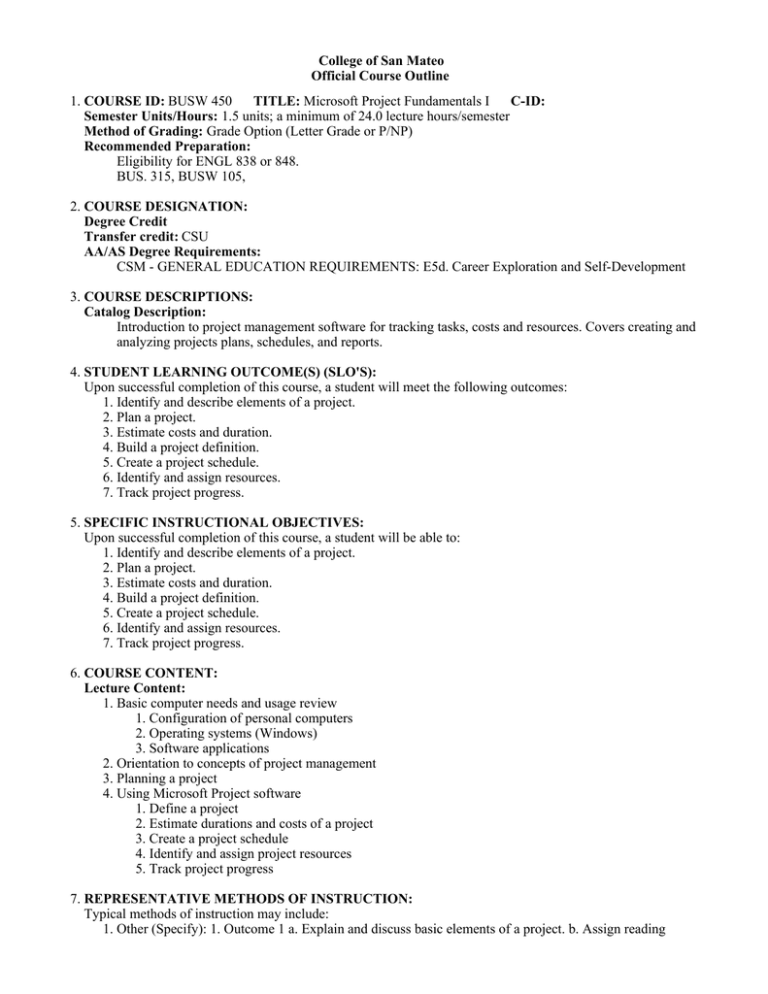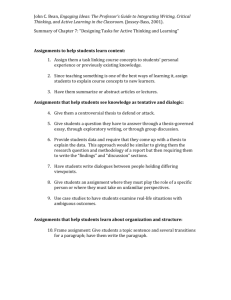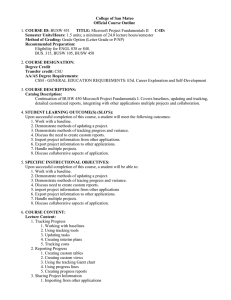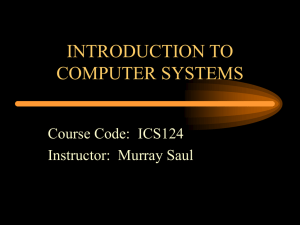College of San Mateo Official Course Outline COURSE ID: Semester Units/Hours:
advertisement

College of San Mateo Official Course Outline 1. COURSE ID: BUSW 450 TITLE: Microsoft Project Fundamentals I C-ID: Semester Units/Hours: 1.5 units; a minimum of 24.0 lecture hours/semester Method of Grading: Grade Option (Letter Grade or P/NP) Recommended Preparation: Eligibility for ENGL 838 or 848. BUS. 315, BUSW 105, 2. COURSE DESIGNATION: Degree Credit Transfer credit: CSU AA/AS Degree Requirements: CSM - GENERAL EDUCATION REQUIREMENTS: E5d. Career Exploration and Self-Development 3. COURSE DESCRIPTIONS: Catalog Description: Introduction to project management software for tracking tasks, costs and resources. Covers creating and analyzing projects plans, schedules, and reports. 4. STUDENT LEARNING OUTCOME(S) (SLO'S): Upon successful completion of this course, a student will meet the following outcomes: 1. Identify and describe elements of a project. 2. Plan a project. 3. Estimate costs and duration. 4. Build a project definition. 5. Create a project schedule. 6. Identify and assign resources. 7. Track project progress. 5. SPECIFIC INSTRUCTIONAL OBJECTIVES: Upon successful completion of this course, a student will be able to: 1. Identify and describe elements of a project. 2. Plan a project. 3. Estimate costs and duration. 4. Build a project definition. 5. Create a project schedule. 6. Identify and assign resources. 7. Track project progress. 6. COURSE CONTENT: Lecture Content: 1. Basic computer needs and usage review 1. Configuration of personal computers 2. Operating systems (Windows) 3. Software applications 2. Orientation to concepts of project management 3. Planning a project 4. Using Microsoft Project software 1. Define a project 2. Estimate durations and costs of a project 3. Create a project schedule 4. Identify and assign project resources 5. Track project progress 7. REPRESENTATIVE METHODS OF INSTRUCTION: Typical methods of instruction may include: 1. Other (Specify): 1. Outcome 1 a. Explain and discuss basic elements of a project. b. Assign reading assignments. 2. Outcome 2 a. Explain and discuss basic elements of planning a project. b. Assign reading assignments. 2. Outcome 2 a. Explain and discuss basic elements of planning a project. b. Assign reading assignments. 3. Outcome 3 a. Explain and demonstrate Microsoft Project definition tools b. Assign reading assignments and supplementary problems. 4. Outcome 4 a. Explain and demonstrate using Microsoft Project in estimating durations and costs. b. Assign reading assignments and supplementary problems. 5. Outcome 5 a. Explain and demonstrate Microsoft Project scheduling tools. b. Assign reading assignments and supplementary problems. 6. Outcome 6 a. Explain and demonstrate using Microsoft Project in identifying and assigning resources. b. Assign reading assignments and supplementary problems. 7. Outcome 7 a. Explain and demonstrate using Microsoft Project in tracking project progress. b. Assign reading assignments and supplementary problems. 8. REPRESENTATIVE ASSIGNMENTS Representative assignments in this course may include, but are not limited to the following: Reading Assignments: Students will be required to read each chapter and supplementary problem before class. 9. REPRESENTATIVE METHODS OF EVALUATION Representative methods of evaluation may include: 1. 1. Objective 1 a. Give quiz on reading assignment b. Classroom dialog on project basics 2. Objective 2 a. Give quiz on reading assignment b. Classroom dialog on project planning case study 3. Objective 3 a. Classroom dialog on use of Microsoft Project's definition tools. b. Check the completeness of student supplementary problem in use of definition tools. 4. Objective 4 a. Classroom dialog on use of Microsoft Project in estimating costs. b. Check the completeness of student supplementary problem in use of estimating tools. 5. Objective 5 a. Classroom dialog on use of Microsoft Project's scheduling tools. b. Check the completeness of student supplementary problem in use of scheduling tools. 6. Objective 6 a. Classroom dialog on use of Microsoft Project in identifying and assigning resources. b. Check the completeness of student supplementary problem in use of resource tools. 7. Objective 7 a. Classroom dialog on use of Microsoft Project in tracking project progress. b. Check the completeness of student supplementary problem in use of tracking tools. 10. REPRESENTATIVE TEXT(S): Possible textbooks include: 1. Bunin. Microsoft Project 2010, ed. Cengage Learning, 2012 Origination Date: August 2010 Curriculum Committee Approval Date: November 2012 Effective Term: Fall 2013 Course Originator: Patricia Brannock /body



